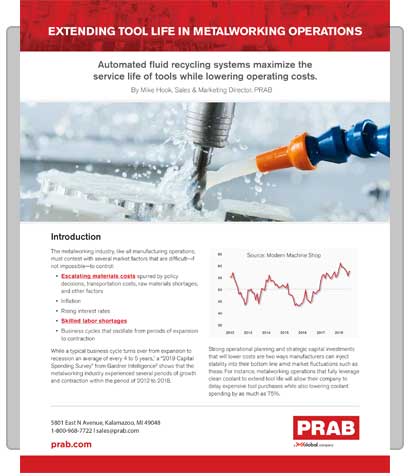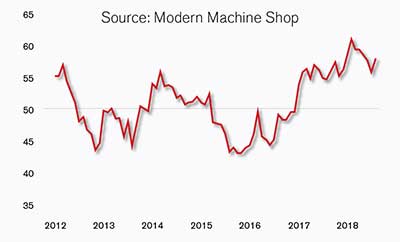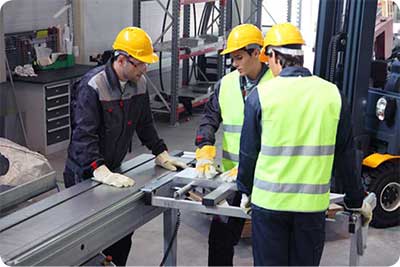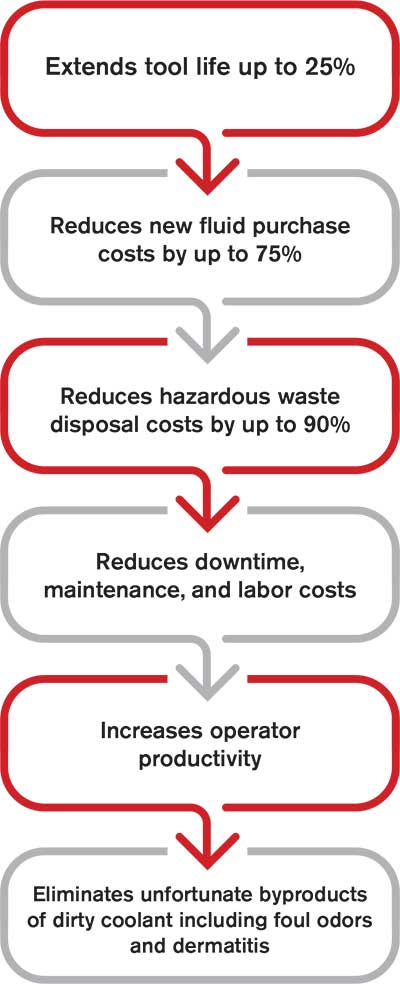
The metalworking industry, like all manufacturing operations, must contest with several market factors that are difficult if not impossible to control:
While a typical business cycle turns over from expansion to recession an average of every 4 to 5 years,1 a “2019 Capital Spending Survey” from Gardner Intelligence2 shows that the metalworking industry experienced several periods of growth and contraction within the period of 2012 to 2018.
Strong operational planning and strategic capital investments that will lower costs are two ways manufacturers can inject stability into their bottom line amid market fluctuations such as these. For instance, metalworking operations that fully leverage clean coolant to extend tool life will allow their company to delay expensive tool purchases while also lowering coolant spending by as much as 75%.


Coolant plays a vital role in metalworking providing lubrication and removing heat from the work zone. Through lubrication, the power required to form a chip-and the heat generated – decreases. Coolant prevents tools from exceeding critical temperature ranges during cutting.
However, the fluid is subject to deterioration over time as it becomes contaminated with tramp oils, metal fines, and bacteria. As the coolant breaks down, it can damage machining tools, pumps, and sumps in the following ways: 3, 4, 5, 6, 7
If coolant isn’t performing correctly, cutting tools soften, wear quickly, and fail to meet tolerances for surface finish and part size if temperatures climb too high.8 If the coolant concentration is too low, cutting tools can dull prematurely or even break during the first cut.7
But the cutting tool/workpiece interface isn’t the only area that is affected by coolant degradation. Tramp oil mist is known to damage sensitive electronic components, an increasingly important consideration in this digital era.6
Repairing or replacing metalworking machinery that wore out prematurely because of coolant contamination, or coolant that doesn’t have the proper concentration, is expensive. Sophisticated machining systems conservatively cost hundreds of thousands of dollars, and cutting tools account for 3% to 5% of total manufacturing cost.9
A Modern Machine Shop article reports that metalworking facilities lose money when they purchase tools earlier than necessary. The article states:
“The combined cost of all of the tools in the shop that have been bought but not yet put to use—tools in tool boxes as well as tools in the crib—is the amount of money the shop has tied up in tooling instead of earning an investment return somewhere else.”
Additional secondary costs to repair or replace machining tools include:
Other tool replacement or repair challenges include the need for custom solutions, and protracted lead times needed by equipment manufacturers to supply the tool/part. Modern Machine Shop reports that in 2017 and 2018, demand for machine tools had surpassed supply so much that average lead times for a machine tool increased from four or five months to eight months to 2 years.2
There are back-end equipment solutions on the market that enable metalworking operations to take control of their coolant through automated filtration and recycling systems. These solutions maximize the service life of tools. Unfortunately, a misconception about initial equipment acquisition costs, and value over the lifecycle of the equipment, persists within the metalworking industry. A product manager for a stamping and tablet/compression division of an international tooling systems manufacturer succinctly sums up the misconception in a Fabricating & Metalworking article:10
“One thing about improvements is that they come at an up-front financial cost, and often that initial investment is the very reason they are overlooked by those who do not think forward enough to understand where value exists.”
A Modern Machine Shop article about tool consumption suggests an additional factor influences equipment acquisition decisions. The article concludes that large metalworking facilities (with more than 100 employees) have fewer financial restraints to prevent them from purchasing new equipment at almost any time. But small metalworking companies (with 100 or fewer employees) tend to buy equipment because of an immediate need.2

Maintaining the coolant manufacturer’s recommended concentration level is essential to achieving lubricity sufficient for protecting the machine tool, and as such, is a major contributor to obtaining maximum service life from metalworking tools. Coolant recycling equipment automates the management of coolant quality by:
Through filtration and recycling, the coolant life is extended two to five times11 over typical change-out periods. The clean, recycled coolant reduces sump maintenance, improves machining quality, and extends tool life. Studies show that tool life can be significantly extended—up to 25%-with effective coolant recycling equipment.11 In addition to prolonged tool life, automated fluid recycling systems significantly reduce new fluid purchase costs and lower hazardous waste disposal costs to provide ROI in multiple ways.

Centralized coolant recycling systems remove tramp oils and suspended solids from contaminated coolant, control bacteria, and can adjust fluid concentration for fluid recovery. The benefits to the bottom line by adding a centralized system include reducing new fluid purchase costs by up to 75% and reducing hazardous waste disposal costs by up to 90%. Utilizing a coolant manager in conjunction with a centralized recycling system can prevent coolant rancidity by injecting ozone. These recycling systems can extend tool life and help a shop reduce new tool purchases by 25%.
Paper bed filters can extend tool life by an average of 27%, improve surface finish, and prolong coolant life by removing solids and other materials from all free-flowing industrial process liquids. Standard paper bed filtration systems are available with flow rates up to 130 GPM and different classes of filter fabric. This allows for adjustments of micron clarity to achieve optimal removal of ferrous and non-ferrous metals as well as organic and inorganic contaminants, such as dirt, glass, rubber, and plastic.
Magnetic separators also prolong tool life and are well suited to processes where ferrous contaminants are mixed with water based coolants or straight cutting oils. They employ high-intensity ferrite or rare earth magnets within a fully energized rotating drum to continuously remove ferrous particles from the flow of liquid, which can reduce machine downtime by up to 50% a major contributor to a healthy profit margin. These systems are often used as a pre-filter to limit contaminants reaching subsequent filtration equipment.
Drum-type scraper separators extend the life of cutting tools and provide cleaner surface finish through high-quality separation of aluminum, non-ferrous, and composite materials. These units also increase coolant life, reduce new coolant purchases, and increase coolant pump life cycle by reducing the risk of coolant lines clogging.
Solid bowl centrifuges prolong coolant and tool life, and improve surface finish of the component part. This industrial centrifuge effectively separates solids from liquids in metal processing applications where removal of fines is important to recycle and reuse goals. It provides high-performance liquid/solid separation for all types of particles including metallic, ferrous, non-ferrous, and non-metallic solids. Centrifuges are available in styles that are self-cleaning or manually cleaned.
Vacuum filtration systems extend tool life by eliminating high sludge volume produced in machining centers and grinding applications. Systems range from standard off-the-shelf units to custom engineered designs, with filtration capabilities up to 3,000 GPM for efficient, high volume fluid filtration.
Automatically remove free-floating and mechanically dispersed tramp oils, bacteria, slime, inverted emulsions, and more from individual machine sumps, central systems, and wash tanks with tramp oil separators. This equipment eliminates the need to have employees manually vacuum oil from the rinse tanks or machine sumps, and is capable of reducing tramp oil to less than 1% in a single pass. Additional benefits include reducing new fluid purchase costs up to 75% and reducing hazardous waste volumes up to 90%.
Manufacturers who adhere to equipment replacement schedules to manage prematurely diminished tool life may minimize unexpected downtime, but they do not realize the full value of their tools. Machining companies that invest in back-end systems such as a fluid recycling system reduce operating costs while also extending the value of their assets.
Fluid recycling systems are shown to prolong tool life and significantly reduce new coolant purchases. If your facility’s expectations are to obtain 10 to 15 years of service from metalworking machinery, recycled coolant could help prevent premature wear and add two to three years to the system’s life. Two to three additional years of service during favorable market conditions provides manufacturers the opportunity to invest those savings into other production advancements. A few more years of service during a recession may permit the delay of capital investments until a time of more favorable market conditions. In either scenario, the bottom line will be improved, and the facility will be poised for anything the future holds.

Mike Hook is the Sales & Marketing Director for PRAB and has more than 15 years of mechanical design and application experience. PRAB is a leading manufacturer of engineered conveyors and equipment for processing turnings, chips, and metalworking fluids. PRAB also designs and builds industrial wastewater recycling systems.
1 Investopedia, What’s an Average-Length Boom and Bust Cycle? – https://www.investopedia.com/ask/answers/071315/what-average-length-boom-and-bust-cycle-us-economy.asp
2 Modern Machine Shop, Shops Outside the Core Set of Buyers Are Driving Machine Tool Consumption – https://www.mmsonline.com/blog/post/shops-outside-the-core-are-driving-machine-tool-consumption
3 MRO, 5 Reasons to Keep Machining Coolant Clean – https://www.mscdirect.com/betterMRO/metalworking/5-reasons-keep-machining-coolant-clean
4 Carbide Processors Inc., Why Coolant Becomes Unusable – http://www.carbideprocessors.com/pages/machine-coolant/why-coolant-becomes-unusable.html
5 Acculube, Monitoring and Controlling Coolant Concentration – https://www.acculube.com/lubricant-monitoring-controlling.htm
6 Production Machining, Metalworking Fluid Management and Best Practices – https://www.productionmachining.com/blog/post/metalworking-fluid-management-and-best-bractices
7Coolant Maintenance, Metalworking Fluid Failure & Prevention – https://www.coolantmaintenance.com/coolant_management/coolant_failure_prevention.htm
8Carbide Processors Inc., What Machine Coolant Does – http://www.carbideprocessors.com/pages/machine-coolant/what-machine-coolant-does.html
9Modern Machine Shop, Integrated Tool Management – https://www.mmsonline.com/articles/integrated-tool-management
10Fabricating & Metalworking, Metal Stamping Industry Projections 2019 – http://www.fabricatingandmetalworking.com/2018/11/metal-stamping-industry-projections-for-2019/
11AdvancedManufacturing.org, Managing Shop Coolant and Chips – https://advancedmanufacturing.org/managing-shop-coolants-chips/